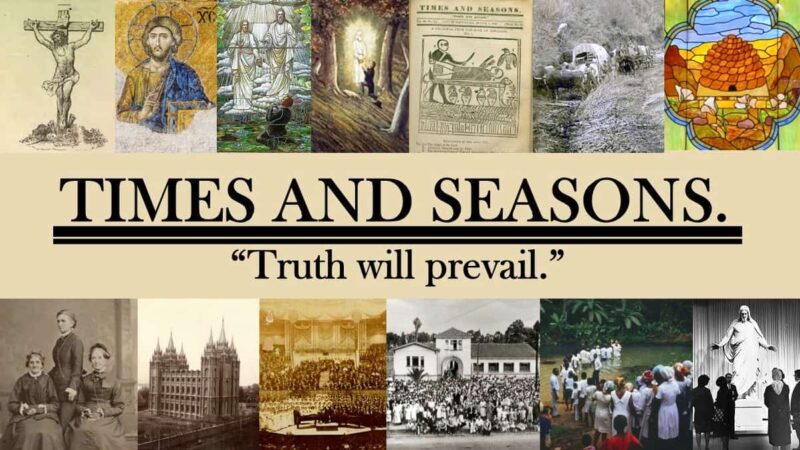Wilford Woodruff was a tremendously successful missionary in his early days as a member of the Church. Through doing so, he offered an example of many praiseworthy attributes, which were discussed by Kristy Wheelwright in her recently published book, Prepare Me for Thy Use: Lessons from Wilford Woodruff’s Mission Years. She also discussed some of Wilford Woodruff’s mission stories in a recent interview at the Latter-day Saint history site, From the Desk. What follows here is a copost to the full interview.
Wilford Woodruff’s conversion took place in the early-1830s. As Kristy Wheelwright explained,
Wilford Woodruff and his older brother Azmon heard two missionaries, Zerah Pulsipher and Elijah Cheney, preach the gospel in Richland, New York at the end of December, 1833.
Wilford felt like he was prepared to hear the message and believed immediately. He said, “We read the Book of Mormon, and I received a testimony that it was true.”
Two days later, on December 31, 1833, he and his brother were baptized.
Woodruff would, in turn, serve missions and baptize many converts. Along the way, he kept a detailed record.
In that record, Woodruff was known to employ humor in telling his stories:
Wilford Woodruff was such a colorful storyteller. Here are a few examples of how he made his records so engaging:
- At age 67, he was on a twelve-foot ladder harvesting peaches when he fell to the ground. We might think he shouldn’t have been up the tree in the first place, but he complains that the devil caused him to lose his balance.
- In Nauvoo, he was finally building the first house that he and Phebe would share, and he said he “flung about seven thousand bricks… nearly melted myself.”
- He also told the story of when he and Phebe were serving a mission in Maine and went digging for clams with a new member couple. He calls this story “Adventures in the Surf,” and it ends with them getting stuck on a sandbar. The two men had to carry their wives back to shore.
These touches add a layer of enjoyment to reading his journal.
Woodruff was not alone in much of his early efforts in the Church. His first wife, Phebe Carter, was tremendously important in supporting his work:
Phebe was a stalwart and brave member of the Church with a strong faith. She was converted in Maine and left her family to join the saints in Kirtland. While there, she met Wilford after his mission to the southern states. Frederick G. Williams married the couple in April 1837 in Joseph Smith’s home.
She supported her husband during his mission years, serving with him in Maine, where their first child was born. She was also with him in England when he presided over the European Mission, where their fifth child was born. …
Even while Phebe struggled at home in Nauvoo while Wilford Woodruff was in England, her letters clearly show that she supported his missionary efforts and loved the gospel. She sounds like other wives with husbands serving in busy callings, wishing they were home, but glad they’re serving the Lord.
Both Phebe and Wilford were great letter writers. She loved to give him news from home, and he loved to get it.
They supported each other in their faith and devotion.
Wheelwright’s interview also touches on some of the later years of Wilford’s life and ministry. For example, she touched on the letter from Wilford Woodruff to Heber J. Grant on March 28, 1887 that I’ve discussed in the past:
When it became clear that John Taylor wouldn’t live much longer, in March 1887, Heber J. Grant, a junior apostle, asked Wilford, the president of the Quorum of the Twelve, if they could skip ahead and let Joseph F. Smith be the next president of the Church.
Wilford was surprised, obviously, but so patient and gracious. He wrote Elder Grant a ten-page letter explaining the earlier apostles’ 1844 meeting with Joseph Smith, in which the Prophet gave the keys of administering the Church to the Quorum of the Twelve. He explained to Elder Grant that since the keys of administering rested with the Quorum, the president of that Quorum—Wilford Woodruff—had the ultimate stewardship of those keys. He closed the letter by telling Elder Grant that he was happy to talk about the matter some more if that was necessary.
Elder Grant felt grateful for President Woodruff’s kind explanation. (I see parallels in President Woodruff’s generous response to that of Pahoran responding to Captain Moroni in Alma 61.)
That letter as a defense to succession would become a meme among Church leaders across the next century.
For more about Wilford Woodruff’s missions, head on over to the Latter-day Saint history site From the Desk to read the full interview with Kristy Wheelwright. While you’re there, check out the new Wilford Woodruff Quotes page!
